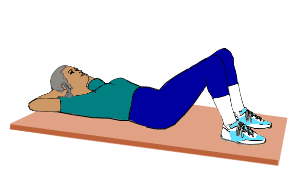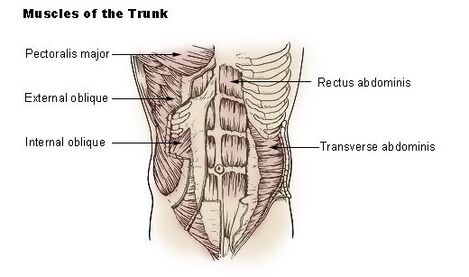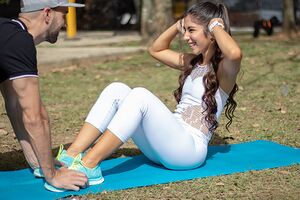Manual Muscle Testing: Trunk Flexion: Difference between revisions
No edit summary |
No edit summary |
||
| Line 5: | Line 5: | ||
</div> | </div> | ||
== Introduction == | == Introduction == | ||
Trunk flexion has | [[File:Abdominal curl-CDC strength training for older adults.gif|thumb|Abdominal curl up]] | ||
Trunk flexion has many elements including cervical, thoracic, and lumbar motion. Measurement is difficult and may be done in a variety of ways with considerable variability in results. | |||
Neck flexors should be eliminated as much as possible. Ask the patient to maintain a neutral neck position with the chin pointed to the ceiling to avoid neck flexion<ref>Musculoskeletal Key Testing the Muscles of the Trunk and Pelvic Floor Available:https://musculoskeletalkey.com/testing-the-muscles-of-the-trunk-and-pelvic-floor/<nowiki/>/ (accessed 30.1.2022)</ref>. | |||
[[File:Trunk muscles.jpeg|thumb|469x469px|Abdominal Muscles]] | |||
== Muscles == | |||
The muscles involved include: | |||
* Rectus abdominis | * Rectus abdominis | ||
| Line 30: | Line 32: | ||
== To Test: == | == To Test: == | ||
* For grade 3 to 5- Patient flexes trunk through complete range of motion. A [[Curl-ups|curl-up]] is emphasized , and trunk is curled until scapulae clear table | * [[File:Curl up.jpeg|thumb|Curl up]]For grade 3 to 5- Patient flexes trunk through complete range of motion. A [[Curl-ups|curl-up]] is emphasized , and trunk is curled until scapulae clear table | ||
* For grade 2- Ask the patient to lift the head from the table. If the scapulae do not clear the table, the Grade is 2. | * For grade 2- Ask the patient to lift the head from the table. If the scapulae do not clear the table, the Grade is 2. | ||
* For grade 0 and 1- therapist uses assisted forward lean technique or coughing techique in same position, while palpating rectus abdominis.<ref>Hislop H, Avers D, Brown M. Daniels and Worthingham's muscle Testing-E-Book: Techniques of manual examination and performance testing. Elsevier Health Sciences; 2013 Sep 27.</ref> | * For grade 0 and 1- therapist uses assisted forward lean technique or coughing techique in same position, while palpating rectus abdominis.<ref>Hislop H, Avers D, Brown M. Daniels and Worthingham's muscle Testing-E-Book: Techniques of manual examination and performance testing. Elsevier Health Sciences; 2013 Sep 27.</ref> | ||
Revision as of 02:35, 31 January 2022
Original Editor - Manali K Shah
Top Contributors - Lucinda hampton, Manali K Shah and Kim Jackson
Introduction[edit | edit source]
Trunk flexion has many elements including cervical, thoracic, and lumbar motion. Measurement is difficult and may be done in a variety of ways with considerable variability in results.
Neck flexors should be eliminated as much as possible. Ask the patient to maintain a neutral neck position with the chin pointed to the ceiling to avoid neck flexion[1].
Muscles[edit | edit source]
The muscles involved include:
- Rectus abdominis
- Obliquus externus abdominis
- Obliquus internus abdominis
Patient Positioning:[edit | edit source]
- Grade 5 (Normal): Supine with fingertips lightly touching the back of the head
- For grade 4- Supine with arms crossed over chest
- For grade 3- Supine with arms at side.
- For grade 0 to 2- Supine with arms at sides and knees flexed.
Therapist Position:[edit | edit source]
- Grade 3 to 5- Standing at side of table at level of patient's chest to be able to see whether scapulae clear table during test
- grade 0 to 2- Standing at side of table with the hand used for palpation is placed at the midline of the thorax over the linea alba, and the four fingers of both hands are used to palpate the rectus abdominis
To Test:[edit | edit source]
- For grade 3 to 5- Patient flexes trunk through complete range of motion. A curl-up is emphasized , and trunk is curled until scapulae clear table
- For grade 2- Ask the patient to lift the head from the table. If the scapulae do not clear the table, the Grade is 2.
- For grade 0 and 1- therapist uses assisted forward lean technique or coughing techique in same position, while palpating rectus abdominis.[2]
References[edit | edit source]
- ↑ Musculoskeletal Key Testing the Muscles of the Trunk and Pelvic Floor Available:https://musculoskeletalkey.com/testing-the-muscles-of-the-trunk-and-pelvic-floor// (accessed 30.1.2022)
- ↑ Hislop H, Avers D, Brown M. Daniels and Worthingham's muscle Testing-E-Book: Techniques of manual examination and performance testing. Elsevier Health Sciences; 2013 Sep 27.









